















RARE Six and One Quarter Carat (Total Weight) Antique Nineteenth Century Genuine Natural Handcrafted Siberian Multi-Color Teardrop Cut Andalusite Semi-Precious Gemstones. Mounted into contemporary high quality 14kt gold fill French hooks.
CLASSIFICATION: Cut and Polished Andalusite Teardrops.
ORIGIN: Chelyabinsk Oblast, South Ural Mountains, Siberia, Russia, Late 18th or Early 19th Century.
SIZE: Length: 9 3/4mm. Diameter: 6mm. All measurements approximate.
WEIGHT: Approximately 6.29 carats (the pair).
NOTE: 14kt solid gold settings and other setting styles (studs, lever backs, euro clicks, kidney wires, ball/stud dangles, etc., are available upon request.
NOTE: If you would like only the gemstones, and not the settings, we can dismount the gemstones and offer you the gemstones without the settings. Just let us know, and yes, we’ll discount the price by the cost of the settings.

DETAIL: Russian literary sources claim that orthodox monks have been carving andalusite into rosary beads for centuries, and that Russian monks used to provide rings cut from andalusite to the Knights Templar of Malta. Talismans of andalusite were also worn by Russian warriors and soldiers with the belief that it instilled bravery. Travelers in Russia wore amulets of andalusite for protection, and both alchemists and philosophers used the stone as an amulet as well. Russian mystics believed that andaulsite aided in necromancy, the ability in séances to contact spirits from the “other side”. Wearing an andalusite talisman on the forehead was believed to be particularly effective. Here are two antique, handcrafted andalusite gemstones which were cut and polished into the teardrops you see here.
Like alexandrite, andalusite is a relatively rare gemstone which is best known for displaying multiple colors ranging from yellow and orange through red and green. In this particular specimen the body of the gemstone varies mostly between orange and green, classic alexandrite colors. Whether the gemstone shows green or orange depends upon the direction of the lighting source. As you reorient the gemstone the color changes from orange to green, the color changes, typically showing both colors within the gemstone, but in different areas as you move the reorient the gemstone within the light. The gemstones were hand shaped and polished in the late eighteenth or early nineteenth century by a Russian artisan, part of an heritage renown for the production of the elaborate gemstones and jewelry of the Czars of Medieval, Renaissance, and Victorian Russia.
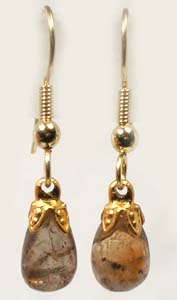 As you can see, these are not high quality gemstones. In fact, they’re quite typical of eighteenth century gemstones both in cut and quality, probably not very different from the rosary beads cut by Russian Monks, or the rings they produced for the Knights Templar of Malta. The earring settings are of contemporary origin. They are high quality settings manufactured by one of the USA’s leading semi-custom mount producers. They are constructed of 14kt gold fill. They are not cheap, gold electroplated earrings. They are of genuine 14kt gold fill, designed to last a lifetime. It's a first-class piece of jewelry throughout. We can reset into 14kt solid gold upon request, and there are also many other setting styles available upon request including euro clicks, lever backs, kidney wires, ball/stud dangles, etc.
As you can see, these are not high quality gemstones. In fact, they’re quite typical of eighteenth century gemstones both in cut and quality, probably not very different from the rosary beads cut by Russian Monks, or the rings they produced for the Knights Templar of Malta. The earring settings are of contemporary origin. They are high quality settings manufactured by one of the USA’s leading semi-custom mount producers. They are constructed of 14kt gold fill. They are not cheap, gold electroplated earrings. They are of genuine 14kt gold fill, designed to last a lifetime. It's a first-class piece of jewelry throughout. We can reset into 14kt solid gold upon request, and there are also many other setting styles available upon request including euro clicks, lever backs, kidney wires, ball/stud dangles, etc.
Under magnification the gemstones show the unmistakable characteristics of having been hand crafted. The coarseness of the eighteenth century finish is considered appealing to most gemstone collectors, and is not considered a detriment, or detract from the value of a gemstone. But these characteristics are not only expected of hand-finished gemstones, most serious collectors consider such gemstones more desirable, possessed of greater character and uniqueness when compared to today's cookie-cutter mass-produced machine-tumbled gemstones. Unlike today’s computer controlled machine produced gemstones, the cut and finish of gemstones such as these is the legacy of an artisan who lived two centuries ago.
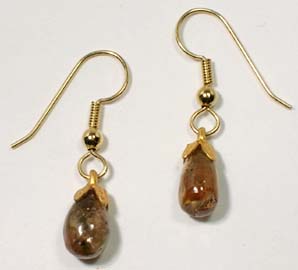
These gemstones have great luster and tone, and to the eye are transparent, but they are clearly now flawless gemstones. However they are quite characteristic of eighteenth century gemstones, and therein lies their value and significance, as historical artifacts, and not so much as gemstones (though as andalusite they are nonetheless fairly rare). In these photo enlargements you can see many blemishes within the gemstones. Of course much the same may said about most natural gemstones. Absolutely flawless gemstones simply are not the rule in nature. Most absolutely flawless gemstones will upon close examination be revealed to be synthetic. You might also notice under magnification occasional irregularities in the cut and finish. Naturally these characteristics are not only expected of hand-finished gemstones, you must also consider that two centuries ago the mining techniques prevalent did not allow the ultra deep mining operations which are so common today.
Keep in mind that two centuries ago mankind was more or less limited to surface deposits or near surface deposits of gemstones. Higher quality gemstones which today are routinely mined from beneath hundreds of meters, even kilometers beneath the earth's surface, were simply inaccessible then. For these reasons antique gemstones must be appreciated as antiques first, gemstones second. The relatively superlative quality of contemporary gemstones routinely mined from deep beneath the earth's surface today were simply not accessible two centuries ago, or at least, only rarely so. However for most, the unique nature and character of antique gemstones such as these more than makes up for minor blemishes both within the gemstone as well as in the finish.
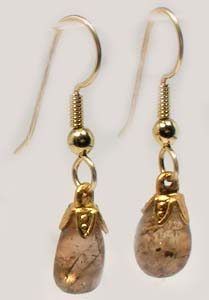
ANDALUSITE HISTORY: Andalusite from southern Spain was first described in literature in 1789. It’s likely that it was known in antiquity, but probably confused with another gemstone such as tourmaline, yellow topaz, or perhaps even citrine. When you consider the number of countries which were part of the Classical Mediterranean, in which andalusite has been discovered, it seems inevitable that it was used at some point in antiquity. Deposits of andalusite (albeit many of them small) have been discovered in Finland, Norway, Sweden, England, Poland, Portugal, Spain, Ireland, France, Germany, Switzerland, Austria, Italy, Macedonia, Bulgaria, Hungary, Czechoslovakia, Armenia, Azerbaijan, Kazakhstan, Tajikistan, Turkey, Georgia, Russia, Ukraine, Iran, Morocco, Egypt, Arabia (United Arab Emirates), Burma (Myanmar), Ceylon (Sri Lanka), Siam (Thailand), China, Mongolia, and India. However today, only a handful of countries produce gemstone quality andalusite, including Spain, Russia, Ceylon, Australia, Brazil, and Canada. Despite the number of localities where andaluste has been discovered, very few of the deposits have produced gemstone quality material. Transparent andalusite of gemstone quality is very rare.
Faceted andalusite gemstones give a play of red, green, and yellow colors that seems almost iridescent (the shimmering play of colors seen with peacock feathers, black opal, black abalone mother-of-pearl, or for instance the sheen of gasoline floating atop a puddle of water). The mixture of colors is the result of unusually strong pleochroism, which means that when viewed from one side the gemstone exhibits one color, while from another side the color appears differently. In fact andalusite is one of the few gemstones which is “tricotic”, meaning three different colors are observable from different angles of view. Because of this andalusite has sometimes been referred to as "poor man's alexandrite" because it offers color play similar to alexandrite, but generally costs considerably less. However whereas alexandrite actually changes color in response to different lighting sources, the multiple colors of andalusite are visible under all lighting conditions, not merely when the light source has been changed. Two other gemstones are part of the same “family” as andalusite, those being silimanite (generally cut as a cat’s-eye cabochon) and kyanite, which is a vibrant blue and also very rare in transparent, gemstone-quality material.
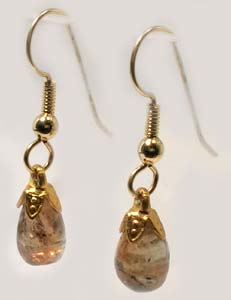
However andalusite has been gaining popularity on its own merits, not merely as an alexandrite substitute. The attraction of andalusite comes from its play of colors if one changes the viewing angle. A similar effect is gained when the light comes from different directions. Andalusite shows shades of yellow, brown, green and reddish brown depending on the orientation of the crystal. Those gemstones cut along the long axis such as an oval, marquis or emerald cut tend to show one color near the center and a second, usually darker color near the ends. Square and round cuts usually blend the colors into a mosaic. Though no record of the use of transparent andalusite gemstones exists from antiquity (at least recognizable references clearly and specifically identifying andalusite as andalusite), one particular variety of andalusite was in fact known in the ancient world as “lapis crucifer”, or “chiastolite”. These gemstones, translucent to near-transparent, contain inclusions of graphite which almost always are in the form of a cross when the gemstone is cut into cross-sections (like a log or sushi roll cut into slices). In Medieval and Renaissance Europe these gemstones were worn by Catholics as an amulet to protect against the “evil eye”. This was in reference to the ancient belief that some evil sorcerers or witches had the ability to transmit evil with just a glance. Certain items of personal adornment (amulets, talismans, etc.) were thought to protect the wearer from the "evil eye" by the proviso of an always watchful open eye.
Though particularly popular as a religious amulet, the “lapis crucifer” gemstone was also popular with the general population of Medieval and Renaissance Europe as well. In Brittany (France) these crystals were worn as a talisman. Local folklore held that the gemstones had dropped from the heavens. It was believed that if the gemstone was worn so as to touch the skin, it would staunch the flow of blood. It was also thought to increase the secretion of milk. If a “lapis crucifer” talisman was worn suspended from the neck, it was thought to cure almost any kind of fever, and the divine symbol it bore served to drive away evil spirits from the vicinity of the wearer. Russian literary sources claim that orthodox monks have been carving andalusite into rosary beads for centuries, and that Russian monks used to provide rings cut from andalusite to the Knights Templar of Malta. Talismans of andalusite were also worn by Russian warriors and soldiers with the belief that it instilled bravery. Travelers in Russia wore amulets of andalusite for protection, and both alchemists and philosophers used the stone as an amulet as well. Russian mystics believed that andaulsite aided in necromancy, the ability in séances to contact spirits from the “other side”. Wearing an andalusite talisman on the forehead was believed to be particularly effective.
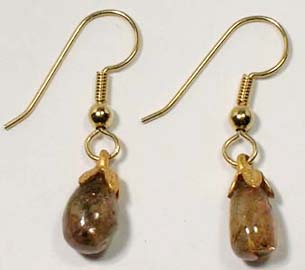
Throughout the history of the ancient world, gemstones were believed capable of curing illness, possessed of valuable metaphysical properties, and to provide protection. Found in Egypt dated 1500 B. C., the "Papyrus Ebers" offered one of most complete therapeutic manuscripts containing prescriptions using gemstones and minerals. Gemstones were not only valued for their medicinal and protective properties, but also for educational and spiritual enhancement. Under what name andalusite crystals (other than “lapis crucifer”) may have been known in the ancient world is indeterminable. Andalusite was likely misidentified as tourmaline or yellow topaz, perhaps even citrine/smoky quartz. Though one type of andalusite, “lapis crucifer”, was well-known in Medieval Europe, history is silent as to how transparent andalusite crystals may have been used for healing or for mystic or shamanic purposes, except in Russian history. As described above, Russian mystics, alchemists, and philosophers all believed that andalusite had mystical powers. Russian history also documents that wearing an andalusite amulet was believed to benefit those suffering from heart and lung diseases, as well as nervous disorders, and was believed to bring harmony into the life of the wearer.
However Western European history is silent as to the uses of andalusite crystals, excepting the variety known as “lapis crucifer” (chiastolite). However it is possible that the beliefs which modern practitioners hold pertaining to andalusite crystals may reflect ancient beliefs. It is common for such beliefs to be carried forward in folklore. In Western Europe and America present-day practitioners believe that andalusite is beneficial in the treatment of eye problems, water retention and calcium and/or iodine deficiencies. It is also said to be useful for those suffering from AIDS. On the metaphysical plane, andalusite is often referred to as “the seeing stone” as it works to “see” the various sides of a person's character, or the various sides of a problem. Thus it is believed to enable the wearer to calmly and objectively analyze their personality and character, or view two sides of a situation or problem. Andalusite is also said to bring balance to one’s life and to enhance memory, mental clarity and intellect, and to stimulate problem solving abilities. Mystics and shamans believe that andalusite can also be used when trying to communicate with the spirit world, and as a talisman is useful to protect the wearer, and to encourage moderation and balance in life.
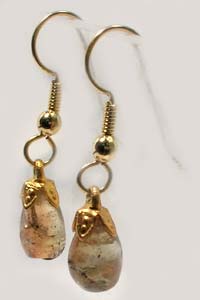
HISTORY OF GOLD: From the earliest of times, gold was often held in awe as the symbol of divinity and was therefore the material of choice for religious objects. Gold was among the first metals to be mined because it commonly occurs in pure form (not combined with other elements), because it is beautiful and imperishable, and because exquisite objects can be made from it. Since gold is found uncombined in nature, early goldsmiths would collect small nuggets of gold from stream beds etc., and then weld them together by hammering. It was oftentimes discovered alloyed with 10%-20% silver, the mixture known as “electrum”. Gold was "discovered" well before 6,000 B.C., most likely in Mesopotamia, though some of the oldest gold objects made by mankind were discovered by archaeologists in present-day Bulgaria (ancient Thrace) and in the Balkans, such as at the Varna Necropolis.
In ancient Egypt all gold was the property of the pharaoh. Artifacts and jewelry of gold over 5,000 years old have been uncovered by archaeologists in Egyptian tombs. Around 3,600 B.C. Egyptian goldsmiths carried out the first smelting of ores using blowpipes made from fire-resistant clay to heat the smelting furnace. Ancient Egyptian hieroglyphs describe gold as the brilliance of the sun. In the Near East, by 2,500 B.C., Sumerian goldsmiths were using sophisticated metalworking techniques; cold hammering, casting, soldering, cloisonné, and particularly filigree (fine-wire ornamentation) and granulation (the use of minute drops of gold). The tomb of the Sumerian Queen Puabi, from the city of Ur in about the 26th century B.C., was one of the richest tombs ever uncovered by archaeologists.
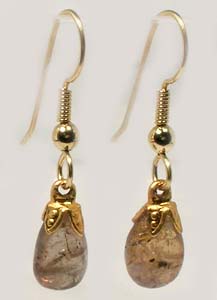 Queen Puabi was buried with five soldiers and thirteen "ladies in waiting" who had apparently poisoned themselves (or been poisoned) to serve their mistress in the next world. The grave goods she was buried with included a magnificent, heavy, gold headdress made of golden leaves, rings, and plates; a superb lyre complete with a gold and lapis-lazuli encrusted bearded bulls head; a profusion of gold tablewear; cylindrical beads of gold, carnelian, and lapis lazuli woven into extravagant necklaces and belts; a chariot adorned with lioness' heads in silver, and an abundance of silver, lapis lazuli, and gold rings and bracelets.
Queen Puabi was buried with five soldiers and thirteen "ladies in waiting" who had apparently poisoned themselves (or been poisoned) to serve their mistress in the next world. The grave goods she was buried with included a magnificent, heavy, gold headdress made of golden leaves, rings, and plates; a superb lyre complete with a gold and lapis-lazuli encrusted bearded bulls head; a profusion of gold tablewear; cylindrical beads of gold, carnelian, and lapis lazuli woven into extravagant necklaces and belts; a chariot adorned with lioness' heads in silver, and an abundance of silver, lapis lazuli, and gold rings and bracelets.
Another of the most famous tombs uncovered by archaeologists was that of 14th century B.C. Tutankhamun. The pharaohs of Egypt insisted on being buried in gold, which they believed was the "flesh of the gods." The boy-king Tutankhamun was enshrined in three gold coffins. The third and final coffin was made of 243 pounds (110 kilograms) of solid gold. As well, gold artifacts and jewelry abounded, including the solid gold mask which weighed 10 kilos (24 pounds). It’s worth noting that Tutankhamun was a minor, almost unknown and forgotten pharaoh. One can only imagine the wealth of gold some of ancient Egypt’s more significant pharaohs (such as Ramses the Great) must have been buried with.
 The art of fashioning gold jewelry reached the Mediterranean island of Crete (the ancient Minoans) about 2400 B.C. Diadems, hair ornaments, beads, bracelets, and complex chains have been found in Minoan tombs. Near Eastern techniques of filigree and granulation were introduced to Crete about 2000 B.C., and evidence also indicates that Egyptian styles influenced Minoan jewelry. Minoan culture and its jewelry styles spread to the mainland of Greece, then dominated by the city-state of Mycenea, about 1550 B.C. The graves of nobles at the ancient Citadel of Mycenae discovered by Heinrich Schliemann in 1876 likewise yielded a great variety of gold figurines, masks, cups, diadems, and jewelry, plus hundreds of decorated beads and buttons. These elegant works of art were created by skilled craftsmen more than 3,500 years ago.
The art of fashioning gold jewelry reached the Mediterranean island of Crete (the ancient Minoans) about 2400 B.C. Diadems, hair ornaments, beads, bracelets, and complex chains have been found in Minoan tombs. Near Eastern techniques of filigree and granulation were introduced to Crete about 2000 B.C., and evidence also indicates that Egyptian styles influenced Minoan jewelry. Minoan culture and its jewelry styles spread to the mainland of Greece, then dominated by the city-state of Mycenea, about 1550 B.C. The graves of nobles at the ancient Citadel of Mycenae discovered by Heinrich Schliemann in 1876 likewise yielded a great variety of gold figurines, masks, cups, diadems, and jewelry, plus hundreds of decorated beads and buttons. These elegant works of art were created by skilled craftsmen more than 3,500 years ago.
Metalworking techniques reached northern Europe by about 2000 B.C., and the earliest jewelry found there dates from between 1800 and 1400 B.C. These artifacts include lunulae (spectacular, crescent-shaped neck ornaments of beaten gold), most of which were found in graves in Ireland, where gold was once plentiful. There is evidence that the Celtic and early British people were trading with the Eastern Mediterranean races by this time, exchanging gold for faience beads. By 1200 B.C. jewelry making was flourishing in Central and Western Europe, where bronze as well as gold was frequently used to make jewelry, and the spiral was the most common motif of decoration. The fibula-brooch seems to have been invented at about this time.
 Twisted gold torcs, modeled on Scandinavian bronze prototypes, were made in the British Isles and northern France from the fifth to the first century B.C. These massive circlets for the necks and arms were the characteristic ornaments of the chiefs of the Celtic race, and were symbols of wealth, power and courage across Celtic Europe. Celtic craftsmen also used enamel and inlay to decorate jewelry. By the seventh century B.C. the Etruscans of Central Italy were also making fine gold jewelry. These people may have migrated from Anatolia (present-day Turkey), from where their metalworking skills seem to have been derived. The Etruscans brought to perfection the difficult technique of granulation, whereby the surface of the metal is covered with tiny gold grains.
Twisted gold torcs, modeled on Scandinavian bronze prototypes, were made in the British Isles and northern France from the fifth to the first century B.C. These massive circlets for the necks and arms were the characteristic ornaments of the chiefs of the Celtic race, and were symbols of wealth, power and courage across Celtic Europe. Celtic craftsmen also used enamel and inlay to decorate jewelry. By the seventh century B.C. the Etruscans of Central Italy were also making fine gold jewelry. These people may have migrated from Anatolia (present-day Turkey), from where their metalworking skills seem to have been derived. The Etruscans brought to perfection the difficult technique of granulation, whereby the surface of the metal is covered with tiny gold grains.
Gold was plentiful in Greece during the Hellenistic Age (323-30 B.C.), and Greek jewelry of this period is characterized by its great variety of forms and fine workmanship. Naturalistic wreaths and diadems were made for the head, and a variety of miniature human, animal, and plant forms were made up into necklaces and earrings. The so-called Heracles-knot, of amuletic origin, was introduced, and remained a popular motif into Roman times. The ancient Mediterranean civilizations appear to have obtained most their supplies of gold from various deposits in the Middle East, as well as gold which came through the Middle East from Southern Africa, and perhaps a minor amount from the Ural Mountains of present-day Russia.
 Mines in the region of the Upper Nile (south of Egypt) near the Red Sea and in the Nubian Desert area supplied much of the gold used by the Egyptian Pharaohs (the area was known to the ancient Egyptians as “Punt”, and to the ancient Christians as “Sheba” or “Saba”). When these mines could no longer meet Egypt’s demand for gold, deposits elsewhere were exploited, likely including deposits thousands of miles away in Southern Africa. Archaeological evidence indicates that most of the gold in Ancient Egypt and even in the ancient Mediterranean from perhaps 1700 B.C. onwards came from the Himyarites in present-day Yemen (across the Red Sea from Nubia), who in addition to exploiting their own deposits, may in turn have obtained much of the gold they exported to the ancient Egyptians from present day Rhodesia/Zimbabwe.
Mines in the region of the Upper Nile (south of Egypt) near the Red Sea and in the Nubian Desert area supplied much of the gold used by the Egyptian Pharaohs (the area was known to the ancient Egyptians as “Punt”, and to the ancient Christians as “Sheba” or “Saba”). When these mines could no longer meet Egypt’s demand for gold, deposits elsewhere were exploited, likely including deposits thousands of miles away in Southern Africa. Archaeological evidence indicates that most of the gold in Ancient Egypt and even in the ancient Mediterranean from perhaps 1700 B.C. onwards came from the Himyarites in present-day Yemen (across the Red Sea from Nubia), who in addition to exploiting their own deposits, may in turn have obtained much of the gold they exported to the ancient Egyptians from present day Rhodesia/Zimbabwe.
In fact the Himyarites likely controlled most of the east coast of Africa, including Rhodesia/Zimbabwe, and is most likely the area referred to as Monomotapa in ancient texts (known also as the Biblical city of Ophir, from which the Bible records that King Solomon received shipments of gold, silver, ivory, gemstones, and peacocks). Artisans in Mesopotamia and Palestine probably obtained their supplies either directly from the Himyarites or indirectly through (middleman) Egypt. As well, recent studies of the ancient mines in the present Kingdom of Saudi Arabia (directly to the north of Yemen) reveal that gold, silver, and copper were recovered from the Red Sea region, across the Red Sea from the Nubian deposits, during the reign of King Solomon (961-922 B.C.).
 Around 1500 B.C. artisans of the ancient world developed the “lost wax” method of producing jewelry, allowing for the “mass production” of gold jewelry. At the same time, gold had already become the recognized medium of exchange for international trade. The sixth century B.C. saw the first use of gold in dentistry by the ancient Egyptians, and the introduction of the first gold coinage in Asia Minor by King Croesus of Lydia. By this time, much of the gold in the Classical Mediterranean cultures came from Spain, where extensive deposits of gold and silver were mined and then acquired by the ancient Phoenicians in trade, and then brought from the Western Mediterranean and traded through the ancient Mediterranean world.
Around 1500 B.C. artisans of the ancient world developed the “lost wax” method of producing jewelry, allowing for the “mass production” of gold jewelry. At the same time, gold had already become the recognized medium of exchange for international trade. The sixth century B.C. saw the first use of gold in dentistry by the ancient Egyptians, and the introduction of the first gold coinage in Asia Minor by King Croesus of Lydia. By this time, much of the gold in the Classical Mediterranean cultures came from Spain, where extensive deposits of gold and silver were mined and then acquired by the ancient Phoenicians in trade, and then brought from the Western Mediterranean and traded through the ancient Mediterranean world.
Eventually the Phoenician colony of Carthage became the leading power of the Eastern Mediterranean, and gained control over these valuable Spanish deposits. In turn the Carthaginians engaged the Romans in three wars before Spain was lost to the Romans. Spanish gold and silver to a great extent allowed the Romans to expand their empire. The “other” great power of the Classical Mediterranean were the Hellenic Greeks, who by 325 B.C. were mining gold from Gibraltar to Asia Minor. When the gold in Spain began to play out, the Romans turned their attention toward the gold mines in Dacia (modern Romania). The Dacians had historically traded this gold to the Greeks for pottery and to the Scythians for amber. About 100 A.D. the Roman Emperor Trajan conquered Dacia, mainly in order to gain control of these gold mines.
 The Romans also exploited smaller gold deposits found in the British Isles. The Romans used very sophisticated extraction and mining techniques as detailed by the first-century historian and naturalist Pliny the Elder. The Romans were also the first to mass-produce coinage on a monumental scale, the first truly monetized society. Between the second and fourth centuries A.D., the Romans produced millions of gold aureus coins, and billions of silver and bronze coins. At the height of the Roman Empire, there were over 400 mints producing coinage in locations scattered through their dominion. Gold was fashioned into Greek style jewelry during the early Roman Empire, when the chief centers of production were Alexandria, Antioch, and Rome, to which Greek craftsmen had migrated.
The Romans also exploited smaller gold deposits found in the British Isles. The Romans used very sophisticated extraction and mining techniques as detailed by the first-century historian and naturalist Pliny the Elder. The Romans were also the first to mass-produce coinage on a monumental scale, the first truly monetized society. Between the second and fourth centuries A.D., the Romans produced millions of gold aureus coins, and billions of silver and bronze coins. At the height of the Roman Empire, there were over 400 mints producing coinage in locations scattered through their dominion. Gold was fashioned into Greek style jewelry during the early Roman Empire, when the chief centers of production were Alexandria, Antioch, and Rome, to which Greek craftsmen had migrated.
There was an increasing emphasis in producing gold jewelry on incorporating decorative stones; at first garnets, chalcedonies, and carnelians, but later uncut but polished hard gemstones such as diamonds, sapphires, and, notably, emeralds from “Cleopatra’s Mines” in Egypt. Colorful gemstone jewelry was common during the Early Middle Ages in the centuries immediately following the collapse of the Roman Empire. Mediterranean goldsmiths continued to produce jewelry of great refinement, but the jewelry of the European Celtic tribes dominated this period. They produced abstract styles of great splendor which were worked in enamels and inlaid stones. The fibula-brooch reached extremes of size and elaboration. During the High Middle Ages the technique of cloisonné enameling on gold was widespread, the finest pieces emanating from the workshops at Constantinople, the capital of the Byzantine Empire.
 After the creation of Charlemagne's empire in 800 A.D. and the Holy Roman Empire in 962 A.D., a fusion of northern and Mediterranean cultures occurred. The principal patrons of the arts became the emperor and the church, and jewelers worked in courts and monasteries. Jewelry design was based on the setting in gold of precious stones and pearls in colorful patterns. Gold was used widely for crosses, altars, doors, chalices, and reliquaries. This association with divinity naturally developed into an association with royalty. Even in modern times the accoutrements of royalty are predominantly gold. However there was a critical shortage of gold which developed in the High Middle Ages. During the years 1370-1420 A.D. as various major mines around Europe become completely exhausted. Mining and production of gold declined sharply throughout the region in a period known as 'The Great Bullion Famine'.
After the creation of Charlemagne's empire in 800 A.D. and the Holy Roman Empire in 962 A.D., a fusion of northern and Mediterranean cultures occurred. The principal patrons of the arts became the emperor and the church, and jewelers worked in courts and monasteries. Jewelry design was based on the setting in gold of precious stones and pearls in colorful patterns. Gold was used widely for crosses, altars, doors, chalices, and reliquaries. This association with divinity naturally developed into an association with royalty. Even in modern times the accoutrements of royalty are predominantly gold. However there was a critical shortage of gold which developed in the High Middle Ages. During the years 1370-1420 A.D. as various major mines around Europe become completely exhausted. Mining and production of gold declined sharply throughout the region in a period known as 'The Great Bullion Famine'.
However by about 1433 A.D. this spurred the Portuguese to start sailing to Ghana in Western Africa and thus enabling them to trade for gold without having to cross the Sahara Desert into Muslim northern Africa. By 1471 A.D., the Portuguese were even calling West Africa the "Gold Coast", and a reliable source of gold was again available to Western Europe. In the “New World”, archaeologists believe that the gold in the Aztec and Inca treasuries of Mexico and Peru came from Colombia, although some undoubtedly was obtained from other sources. The Aztecs regarded gold as literally the product of the gods, calling it "god excrement". The Conquistadores plundered the treasuries of these civilizations during their explorations of the New World, and many gold and silver objects were melted and re-cast into coins and bars, destroying the priceless artifacts of these MesoAmerican cultures.
 Gold is widely dispersed through the earth's crust (and even in seawater) and is found in two types of deposits; lode deposits, which are found in solid rock and are mined using conventional mining techniques, and placer deposits which are gravelly deposits found in stream beds and are the products of eroding lode deposits. The largest gold nugget ever found was in 19th century Australia weighing over 70 kilograms (150 pounds). Gold is quite unique in its malleability. No other metal compares with it. A single ounce can be stretched into a wire 60 kilometers long (40 miles), or pounded into a sheet of 300 square feet (the size of two typical suburban bedrooms).
Gold is widely dispersed through the earth's crust (and even in seawater) and is found in two types of deposits; lode deposits, which are found in solid rock and are mined using conventional mining techniques, and placer deposits which are gravelly deposits found in stream beds and are the products of eroding lode deposits. The largest gold nugget ever found was in 19th century Australia weighing over 70 kilograms (150 pounds). Gold is quite unique in its malleability. No other metal compares with it. A single ounce can be stretched into a wire 60 kilometers long (40 miles), or pounded into a sheet of 300 square feet (the size of two typical suburban bedrooms).
Because of its chemical inertness, gold retains its brilliant color even after centuries of exposure to corrosive elements. The most workable of all metals, gold has been forged, chased, embossed, engraved, inlayed, cast, and in the form of gold leaf, used to gild metals, woods, leather, and parchment. Gold wire has found wide uses in brocades and ornamentation of other materials. Throughout at least five millennia of recorded history it has been used to fashion sculpture, vessels, jewelry, ornamentation, and coinage. Throughout the history of the ancient world, gemstones were believed capable of curing illness, possessed of valuable metaphysical properties, and to provide protection.
 Found in Egypt dated 1500 B. C., the "Papyrus Ebers" offered one of most complete therapeutic manuscripts containing prescriptions using gemstones and minerals. Gemstones were not only valued for their medicinal and protective properties, but also for educational and spiritual enhancement. In the ancient world, gold was regarded to symbolize power, strength, wealth, warmth, happiness, love, hope, optimism, intelligence, perfection, summer, harvest and the sun. Gold was also believed to possess curative and “magical” properties. During justice, balance, the Middle Ages it was believed that something as rare and beautiful as gold could not be anything but healthy, so gold was regarded as beneficial for health and was not only worn but also ingested.
Found in Egypt dated 1500 B. C., the "Papyrus Ebers" offered one of most complete therapeutic manuscripts containing prescriptions using gemstones and minerals. Gemstones were not only valued for their medicinal and protective properties, but also for educational and spiritual enhancement. In the ancient world, gold was regarded to symbolize power, strength, wealth, warmth, happiness, love, hope, optimism, intelligence, perfection, summer, harvest and the sun. Gold was also believed to possess curative and “magical” properties. During justice, balance, the Middle Ages it was believed that something as rare and beautiful as gold could not be anything but healthy, so gold was regarded as beneficial for health and was not only worn but also ingested.
In fact, some gold salts do have anti-inflammatory properties, and in modern times, injectable gold has been proven to help to reduce the pain and swelling of rheumatoid arthritis and tuberculosis. The isotope gold-198 is also used in some cancer treatments and for treating other diseases. Gold flake was used by the nobility in Medieval Europe as a decoration in food and drinks, in the form of leaf, flakes or dust, either to demonstrate the host's wealth or in the belief that something that valuable and rare must be beneficial for one's health. Even today gold leaf, flake or dust is used on and in some gourmet foods, notably sweets (particularly in India and the Middle East) and drinks as decorative ingredient.
 SHIPPING & RETURNS/REFUNDS: Your purchase will ordinarily be shipped within 48 hours of payment. We package as well as anyone in the business, with lots of protective padding and containers. All of our shipments are fully insured against loss, and our shipping rates include the cost of this coverage (through stamps.com, Shipsaver.com, the USPS, UPS, or Fed-Ex). International tracking is provided free by the USPS for certain countries, other countries are at additional cost. ADDITIONAL PURCHASES do receive a VERY LARGE discount, typically about $5 per item so as to reward you for the economies of combined shipping/insurance costs. We do offer U.S. Postal Service Priority Mail, Registered Mail, and Express Mail for both international and domestic shipments, as well United Parcel Service (UPS) and Federal Express (Fed-Ex). Please ask for a rate quotation. We will accept whatever payment method you are most comfortable with.
SHIPPING & RETURNS/REFUNDS: Your purchase will ordinarily be shipped within 48 hours of payment. We package as well as anyone in the business, with lots of protective padding and containers. All of our shipments are fully insured against loss, and our shipping rates include the cost of this coverage (through stamps.com, Shipsaver.com, the USPS, UPS, or Fed-Ex). International tracking is provided free by the USPS for certain countries, other countries are at additional cost. ADDITIONAL PURCHASES do receive a VERY LARGE discount, typically about $5 per item so as to reward you for the economies of combined shipping/insurance costs. We do offer U.S. Postal Service Priority Mail, Registered Mail, and Express Mail for both international and domestic shipments, as well United Parcel Service (UPS) and Federal Express (Fed-Ex). Please ask for a rate quotation. We will accept whatever payment method you are most comfortable with.
Please note for international purchasers we will do everything we can to minimize your liability for VAT and/or duties. But we cannot assume any responsibility or liability for whatever taxes or duties may be levied on your purchase by the country of your residence. If you don’t like the tax and duty schemes your government imposes, please complain to them. We have no ability to influence or moderate your country’s tax/duty schemes. If upon receipt of the item you are disappointed for any reason whatever, I offer a no questions asked 30-day return policy. Send it back, I will give you a complete refund of the purchase price; 1) less our original shipping/insurance costs, 2) less any non-refundable eBay fees. Please note that though they generally do, eBay may not always refund payment processing fees on returns beyond a 30-day purchase window. So except for shipping costs and any payment processing fees not refunded by eBay, we will refund all proceeds from the sale of a return item. Obviously we have no ability to influence, modify or waive eBay policies.
ABOUT US: Prior to our retirement we used to travel to Eastern Europe and Central Asia several times a year seeking antique gemstones and jewelry from the globe’s most prolific gemstone producing and cutting centers. Most of the items we offer came from acquisitions we made in Eastern Europe, India, and from the Levant (Eastern Mediterranean/Near East) during these years from various institutions and dealers. Much of what we generate on Etsy, Amazon and Ebay goes to support worthy institutions in Europe and Asia connected with Anthropology and Archaeology. Though we have a collection of ancient coins numbering in the tens of thousands, our primary interests are ancient/antique jewelry and gemstones, a reflection of our academic backgrounds.
Though perhaps difficult to find in the USA, in Eastern Europe and Central Asia antique gemstones are commonly dismounted from old, broken settings – the gold reused – the gemstones recut and reset. Before these gorgeous antique gemstones are recut, we try to acquire the best of them in their original, antique, hand-finished state – most of them originally crafted a century or more ago. We believe that the work created by these long-gone master artisans is worth protecting and preserving rather than destroying this heritage of antique gemstones by recutting the original work out of existence. That by preserving their work, in a sense, we are preserving their lives and the legacy they left for modern times. Far better to appreciate their craft than to destroy it with modern cutting.
Not everyone agrees – fully 95% or more of the antique gemstones which come into these marketplaces are recut, and the heritage of the past lost. But if you agree with us that the past is worth protecting, and that past lives and the produce of those lives still matters today, consider buying an antique, hand cut, natural gemstone rather than one of the mass-produced machine cut (often synthetic or “lab produced”) gemstones which dominate the market today. We can set most any antique gemstone you purchase from us in your choice of styles and metals ranging from rings to pendants to earrings and bracelets; in sterling silver, 14kt solid gold, and 14kt gold fill. When you purchase from us, you can count on quick shipping and careful, secure packaging. We would be happy to provide you with a certificate/guarantee of authenticity for any item you purchase from us. There is a $3 fee for mailing under separate cover. I will always respond to every inquiry whether via email or eBay message, so please feel free to write.

